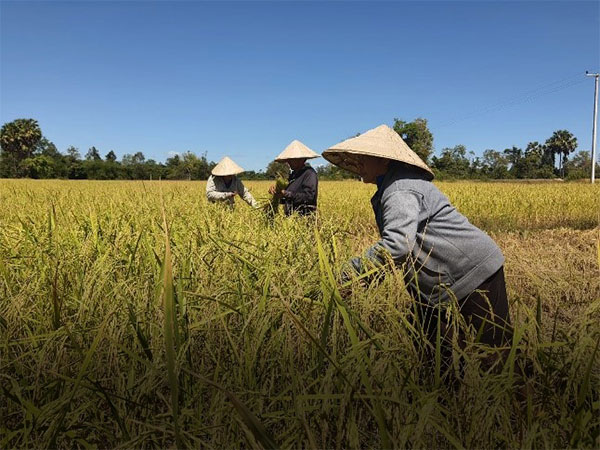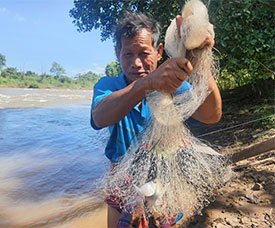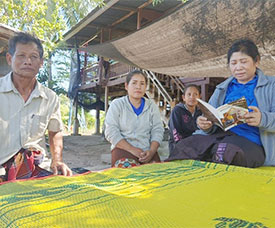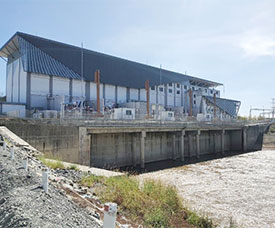Women need support to cope with Mekong challenges
In a small community on the Mekong island of Don Sahong in the far south of Laos, a 56-year-old woman stands up among a small gathering to greet visitors. Under the shade of a large tree, she communicates with the assembled audience in a soft voice and with gentle body gestures.
 |
| Don Sahong villagers are growing jasmine rice after learning that the market price of the crop is rising. |
“Sisters, come on, please take your sickles and follow me,” Ms Kaysone Vilavong said as she left the coolness of the shady tree and led a group of women to a golden paddy field located not far from her traditional Lao-style house.
In the late morning sunshine, Ms Kaysone and her group quickly set about the task of harvesting the paddy rice. Clearly, they are giving the visitors the sense that they have strong leadership and are committed to embracing changes to their way of life.
Climate change and ongoing developments along the Mekong are having a significant impact on the livelihoods of riparian communities, especially women. And there is no exception for the 75 households in Don Sahong village.
New opportunities
In an interview with the Vientiane Times, Ms Kaysone, who heads the Don Sahong green agricultural production group, said that since the 260MW Don Sahong hydropower plant was built in 2016, the community has been given new opportunities to thrive thanks to an improved land transport connection and irrigation, as well as livelihood restoration aid from the dam project.
However, this marginalised community is facing multiple challenges, especially how to make the long-term shift from being a fishing village to a more sustainable commercial farming community.
In the past, Don Sahong village was a rich fishing area of Khong district. Villagers caught fish from the Mekong River for their own consumption and for sale to city markets. But the continuing depletion of fish stocks means the community has had to find more jobs and sources of income.
“Plentiful fish stocks are a thing of the past,” Ms Kaysone told the Vientiane Times, adding that apart from eating the fish they caught, villagers earned a lot of money from fishing.
 |
| A Don Sahong villager says they still catch fish but in much smaller quantities than in the past. |
“In the past, if we wanted to eat fish, we just put a cooking pot on the stove and then headed to the Mekong,” she said, recalling her memories a long time ago.
Faced with the need to diversify their food security base, the villagers decided to raise ducks and grow vegetables for commercial purposes as an alternative source of income in response to the change.
Ms Kaysone said the community began raising ducks for commercial purposes in 2019. In 2020, the number of ducks owned by the group exceeded 1,000 but unfortunately this new business was disrupted by the Covid-19 pandemic.
“During the pandemic, travel restrictions meant we could not leave the village to sell the ducks and traders were not allowed to come here to buy them,” she said, explaining why villagers now had fewer ducks.
But despite suffering multiple failures in duck farming, the Don Sahong community did not give up and this year they began growing jasmine rice after realising that the market price for the crop was increasing.
Ms Kaysone said this was the first year that her group had grown rice on a commercial basis after a year of experimentation, with everyone hoping the crop would provide them with a better income.
“Our group is now growing jasmine rice on more than eight hectares,” she said, adding that they hoped they would not have to suffer failure again in the coming years.
Coping with new challenges
When asked how the villagers were adapting to developments on and around the Mekong, Ms Kaysone said that a number of people had found the change very challenging.
“I keep telling the members of our group that change is never easy, but it doesn’t mean it’s impossible,” she said.
“I told them that if we do not change the way we live and how we make a living, we are not going to survive. Things have changed.”
Ms Kaysone said some people had been unable to make the switch and had gone to Thailand to find work, adding that most of them, especially young people, viewed this option as their best choice.
“Raising animals for commercial purposes is something new for our community and some people are reluctant to branch out and put their savings into a different venture,” she added.
A lecturer and researcher in agricultural economics at Champassak University, Mr Vannasinh Souvannasouk, who observed the Don Sahong community development project, said it would take some time for the villagers to learn new ways of earning a living.
“The nature of change is difficult and takes time,” he said, adding that authorities and stakeholders should continue to support those who had decided to take up farming, and observing that the university has the capacity and resources to provide training that would restore people’s livelihoods.
 |
 |
| Ms Kaysone Vilavong discusses the opportunities and challenges her community is facing. |
The Don Sahong hydro dam offers new development opportunities. |
Fighting to make their voices heard
The chief of Don Sahong village, Mr Khamlay Sonalin, said the villagers had asked the hydropower project to subsidise the cost of the electricity they used for agriculture by at least 50 percent, under the project’s livelihood restoration plan.
“The hydropower operator is considering our request,” he said, adding that if it is approved, it would make investment in agriculture a more attractive proposition.
The Livelihood Restoration Project officer with the Don Sahong hydropower project, Mr Daosone Manivong, said the relevant authorities are looking into the possibility of assisting villagers affected by the dam as requested, but could not say how much the company could offer them.
“The proposal is being considered by the joint committee in charge of the livelihood restoration fund set up by the Don Sahong hydropower project,” he said, adding that the agreed aid package is US$1 million a year and will continue for 25 years throughout the concession period.
Social and Environmental Manager at the dam project, Mr Somphon Phomanivong, said that in order to fulfill the dam’s obligations under the rules of the Mekong River Commission, the project improved 13 sub-natural Mekong channels to enable fish migration.
He said the project continues to monitor fish migration and has learnt that fish stocks are declining not only in the Don Sahong area but along the whole of the Mekong River. This was done to ensure fish could reproduce and that fish populations could be sustained in these areas.
In conclusion, climate change and developments along the Mekong are causing significant impacts to the livelihoods of marginalised communities, especially women. Despite facing multiple challenges, the Don Sahong community has shown their commitment to embrace change. However, a key lesson learnt by reporters during a visit to the area is that it is difficult and takes time for affected communities to adopt new development approaches.
This is perhaps an opportunity to review the role of women in Mekong water resource governance, to ensure that the economic growth generated by this mighty river is inclusive and sustainable.
Only this way will women’s voices be heard and their legitimate interests protected. If this can be achieved, no one will be left behind amid the rapid economic growth taking place around the Mekong.
This article has been funded by a story grant under a project by Internews on Mekong Water Governance from a Gender and Social Inclusion Lens.
By Ekaphone Phouthonesy
(Latest Update November 25, 2022)
|